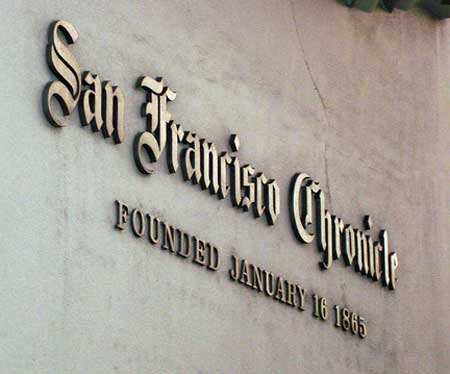Employee empowerment is about creating brand advocates to scale customer relationships and effectively compete in new digital markets. Organizations can no longer rely on inbound and outbound sales reps, people willing to jump through hoops and obstacles via call centers, or traditional marketing to boost awareness and demand. Customers demand engagement, in real time, and that takes human beings, training, and support.
In January 2014, the San Francisco Chronicle, one of the country’s oldest remaining metropolitan newspapers, opened a technology incubator. The declining but still important media company is investing in a rigorous digital boot camp for reporters to learn how to use social and mobile media to boost views, amplify sharing, and increase views and engagement. The Chronicle has no choice. Circulation plummeted 50% between 2009 and 2012. Revenue too is just not what it used to be. More importantly, readership is no longer the same as it was. Gripping headlines, animated GIFs, infographics, punchier copy, and innovative content marketing techniques are changing how people read and also how and what they share.
This move sends a loud and alarming message to executives everywhere, “adapt or die.” And to do that, businesses need to embrace not only new technology but also empower employees to engage with customers and stakeholders in the places where their attention is focused in ways that are culturally relevant. Employees must add value in every touch point and at every moment of truth throughout the customer lifecycle if they hope stay competitive.
The truth is that we live in a digital economy now and how people connect with businesses isn’t just changing, it’s continually evolving. There isn’t just one new strategy or technology investment that helps you become relevant though. Merely flocking to social media isn’t enough. Launching mobile apps without vision or purpose isn’t effective. To compete, organizations have to understand customer preferences, behaviors, technology, and their evolving preferences and expectations in real life and in each online network they use to make decisions and share experiences.
With or without you, customers will talk to one another online. They already are to great extent. Even the quiet customers will find the engagement of others instructive. The point is that without you, they will make decisions and form impressions either for or against you. Why leave it to chance?
For years now, experts have begged companies to embrace social media to build bridges to customers where they’re already engaged. And for years, many businesses have experimented with stepping outside of owned media channels to engage with customers in social networks and online communities. For those who know what they’re doing, success has been reeled in the form of improved customer satisfaction, referrals and sales, and loyalty…basically, everything that matters.
So what’s standing in your way?
Fear of risk?
Lack of confidence or ROI?
Ask yourself, what’s the risk of you not engaging? The answer is as stark as it is true. If you don’t compete for relevance, you by default open the door to irrelevance as customers eventually go elsewhere or competitors step in to help.
What of the ROI of empowering employees to engage customers in social channels? Aside from the aforesaid benefits, what’s the ROI of ignorance?
There are great benefits for any organization that realizes that the initial return on engagement and experience is more valuable relationships and reciprocity. That equates to increases in customer lifetime value and also referrals.
In either case, reward is great for those empower employees to reach beyond the everyday customer engagement strategies of laggard companies that ignore the perils or opportunities of digital Darwinism. Thankfully there are companies that help other companies adopt new technologies not because of trendiness but instead to do great things.
Brand Case Study – H&R Block
SF Chronicle is not alone in its play to compete in this digital economy. Enterprise social media management software provider Expion shared a convincing example of how a leading financial services company empowered 100,000 employees to engage customers in social and mobile platforms. Out of the gate, such an example would prove almost impossible. 1) Financial services is bound by regulation and lawyers are extremely reticent to rock the boat, 2) 100,000 employees presents scale and risk challenges, and 3) budget and training to enable so many employees to be effective would be astronomical.
H&R Block sees customer engagement is a powerful and effective form of service and public relations. In fact, H&R Block believes the entire workforce is part of the PR and marketing team. To “deputize” them, H&R Block partnered with Expion to co-develop a mobile app, H&R Block Publisher, that connects helpful social content to clients seeking direction. As you can imagine, during tax season H&R Block representatives are in high demand every tax season. By empowering them to share useful content that speaks to the tax and money issues that are important to clients and also answer question, the program developed deeper and more meaningful relationships with clients.
Scott Gulbransen, Director of Social Business Strategy for H&R Block views employee empowerment as a direct link to customer relationships, “They [H&R Block reps] are already seen as trusted resources to their friends and family. By our corporate team offering tips, it takes the ‘marketing’ out of the equation…it’s relationship-based value add.”
Said another way, representatives are able to earn trust beyond their friends and family. They now extend their communities to also build trust and relationships with clients.
In both the SF Chronicle and H&R Block examples, empowering employees is an investment in relevance and relationships with social and mobile serving as an engaging platform for connecting with customers. Good intentions are just the beginning. What we’re also building here is trust and value and that is priceless. But doing so isn’t a stationary gesture. It’s an investment that requires commitment and ongoing support to scale. In the process, you learn more about the evolving expectations and behaviors of your connected (social and mobile) customers. And by learning to engage with them on their terms, in their networks of preference, in ways that are mutually beneficial, everyone wins. More so, everyone learns and grows together. And that’s what social is about…empowerment, engagement and relationships.
10 Steps to get started on the path to social and mobile relevance…
- Care.
- Identify where your customers are spending most of their time online and mobile.
- Learn what they are asking and how their questions are being answered and by whom.
- Run an audit to see who from your team is already engaging and observe what’s working and what’s not.
- Put together a pilot recommendation to earn buy-in from an executive sponsor. Make sure to outline the benefits on all sides and the expected business outcomes.
- Develop content and engagement strategies that matter. Introduce value, share useful but engaging information, entertain, and engage.
- Invest in technology that facilitates seamless engagement and scale.
- Train employees before you turn them loose on technology, expectations, best practices and performance measurement.
- Test and learn.
- Repeat.
Connect with me: Twitter | LinkedIn | Facebook | Google+ |Youtube | Instagram
Originally published at Expion.







Brian Solis
gets it right here with empowerment of employees in an “adapt or die”
scenario for businesses. However, this adaptability, empowerment, and
engagement requires that companies address change issues that lurk
underneath the surface of what employees are doing currently. This is
really a change management issue as well as a training issue that moves
employees from their current roles in an organization to other more
social roles as advocates, which they may not be prepared or comfortable
with.
Once again the changes and transitions are coming at a quickened and
alarming rate and companies that are prepared for these shifts as part
of their DNA will be the survivors.
Hello, I was wondering if you think that the age and demographic of the average customer should have an effect on what kind of social media you invest in? Maybe older clients would only really look at a website or a print ad, while younger clients are more interested in facebook and twitter?
Hello Sarah, great question! Please google my name and “Generation-C” and download or read everything I made freely available. This is a bit more complex but the answers are there.
Good luck!
What better way to compete for relevance than to get all your human assets involved in the process. Having the most important part of your business– people– engaging on social and improving the customer experience makes sense to me. Sharing this post over the weekend!
Love your comment Mitch! Keep changing the world!
Spot on! Thanks for a great post. Sharing out.
Cheers!
Any reason you gave two case studies with ZERO proof the efforts worked? You do this all the time Brian. And Journalists using social media to expand reach is nothing new. It is actually 2010. As for H&R Block what are these 100k people doing? Are they just finding articles created at Corporate and sharing them? Are they tweeting with customers? Can you show us some examples of what they have been doing? Has it led to any success? The app looks great but what does it have to do with the employees?
And why are the only examples of empowering employees with companies that pay well vs the companies like Walmart and McDonald’s and Subway who pay minimum wage?
I had a close friend who was a photographer for a national newspaper. She
had been nominated for a Pulitzer Prize 3 times. The newspaper recently let her go. They
told her that the journalists were all given iPhones and that her services
would no longer be needed. They hired a few young kids and started to focus on
digital media and viral content. As a result, the quality of the newspaper has
suffered a great deal. It basically exists now online as a gossip website to
re-post pictures of Lady Gaga. While I don’t disagree that you must adapt or
die in the digital era, I definitely don’t think we’re getting the quality content we
once did.
Love this comment. This is happening at many publications unfortunately. Everything comes down to objectives, intentions and purpose of course.
Great insights and case example. Employees can really make a difference when you leverage them the right way.